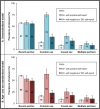Sexual Behaviors and HIV Status: A Population-Based Study Among Older Adults in Rural South Africa
- PMID: 27926667
- PMCID: PMC5147032
- DOI: 10.1097/QAI.0000000000001173
Sexual Behaviors and HIV Status: A Population-Based Study Among Older Adults in Rural South Africa
Abstract
Objective: To identify the unmet needs for HIV prevention among older adults in rural South Africa.
Methods: We analyzed data from a population-based sample of 5059 men and women aged 40 years and older from the study Health and Aging in Africa: Longitudinal Studies of INDEPTH Communities (HAALSI), which was carried out in the Agincourt health and sociodemographic surveillance system in the Mpumalanga province of South Africa. We estimated the prevalence of HIV (laboratory-confirmed and self-reported) and key sexual behaviors by age and sex. We compared sexual behavior profiles across HIV status categories with and without age-sex standardization.
Results: HIV prevalence was very high among HAALSI participants (23%, 95% confidence interval [CI]: 21 to 24), with no sex differences. Recent sexual activity was common (56%, 95% CI: 55 to 58) across all HIV status categories. Condom use was low among HIV-negative adults (15%, 95% CI: 14 to 17), higher among HIV-positive adults who were unaware of their HIV status (27%, 95% CI: 22 to 33), and dramatically higher among HIV-positive adults who were aware of their status (75%, 95% CI: 70 to 80). Casual sex and multiple partnerships were reported at moderate levels, with slightly higher estimates among HIV-positive compared to HIV-negative adults. Differences by HIV status remained after age-sex standardization.
Conclusions: Older HIV-positive adults in an HIV hyperendemic community of rural South Africa report sexual behaviors consistent with high HIV transmission risk. Older HIV-negative adults report sexual behaviors consistent with high HIV acquisition risk. Prevention initiatives tailored to the particular prevention needs of older adults are urgently needed to reduce HIV risk in this and similar communities in sub-Saharan Africa.
Conflict of interest statement
T.W.B. received funding from the Wellcome Trust and NICHD of NIH (R01-HD084233) and NIAID of NIH (R01-AI124389 and R01-AI112339). The other authors have no funding or conflicts of interest to disclose.
Figures



References
-
- Mills EJ, Rammohan A, Awofeso N. Ageing faster with AIDS in Africa. Lancet. 2011;377:1131–1133. - PubMed
-
- Rammohan A, Awofeso N. Addressing HIV prevention and disease burden among Africans aged over 50 years. Trop Doct. 2010;40:171–172. - PubMed
-
- Mills EJ, Bärnighausen T, Negin J. HIV and aging—preparing for the challenges ahead. N Engl J Med. 2012;366:1270–1273. - PubMed
MeSH terms
Grants and funding
LinkOut - more resources
Full Text Sources
Other Literature Sources
Medical

